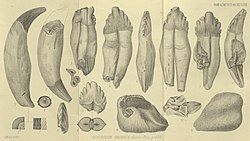Kekenodon is an extinct kekenodontid early whale from the Late Oligocene (Chattian) of New Zealand. Measuring 8–9 m (26–30 ft) long, it was a large raptorial whale which hunted marine mammals and penguins.[1] Although at times classified as a basilosaurid, mysticete, or odontocete, recent work suggests that it represents a phylogenetic intermediate form between Basilosauridae and Neoceti.
| Kekenodon Temporal range:
| |
|---|---|

| |
| Teeth of Kekenodon onamata | |
| Scientific classification | |
| Domain: | Eukaryota |
| Kingdom: | Animalia |
| Phylum: | Chordata |
| Class: | Mammalia |
| Order: | Artiodactyla |
| Infraorder: | Cetacea |
| Family: | †Kekenodontidae Mitchell, 1989 |
| Genus: | †Kekenodon Hector, 1881 |
| Species | |
| |
Classification edit
Kekenodon was considered a member of the basilosaurid subfamily Dorudontinae in the classic monograph on Archaeoceti by Kellogg (1936).[2]
"Squalodon" gambierensis from Australia is a close relative of Kekenodon.[3]
Phylogenetic analysis suggests that Kekenodon is the "latest-surviving archaeocete, sister-taxon to the Neoceti."[1]
References edit
- ^ a b Corrie, Joshua E.; Fordyce, R. Ewan (2022). "A redescription and re-evaluation of Kekenodon onamata (Mammalia: Cetacea), a late-surviving archaeocete from the Late Oligocene of New Zealand". Zoological Journal of the Linnean Society. 196 (4): 1637–1670. doi:10.1093/zoolinnean/zlac019.
- ^ R. Kellogg. 1936. A Review of the Archaeoceti. Carnegie Institution of Washington 482:1-366
- ^ R. E. Fordyce. 2006. A southern perspective on Cetacean Evolution and Zoogeoraphy. Evolution and Biogeography of Australasian Vertebrates 755-782